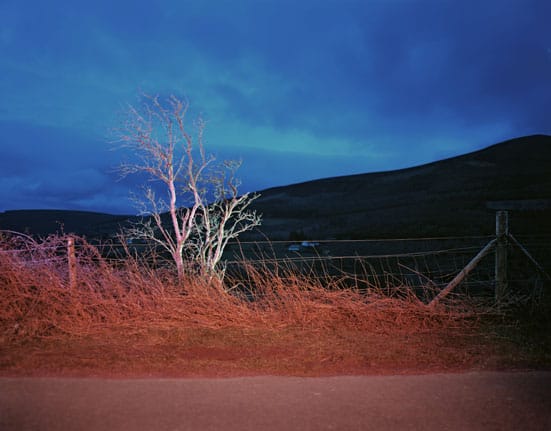22nd March 2007 — 4th May 2007
In
1963, Playboy magazine published a lengthy panel discussion between
twelve famous sci-fi authors in which they speculated upon what the
world might be like in 1984. A restaging of parts of this discussion,
filmed with Dutch actors, forms the centrepiece of Gerard Byrne's first
UK solo exhibition at the Lisson Gallery. Excerpts from the film are
displayed across three video screens, which, along with twenty black
and white photographs, comprise an installation called 1984 and Beyond.
The discussions featured in the film are often quite fascinating and
engaging in their own right, as this odd cabal of good-natured,
chain-smoking boffins speculate and ruminate idealistically upon the
future of such things as technology, politics, sex and everyday life;
as well as deliberating on the rather more clichéd sci-fi
preoccupations of immortality and the likelihood of making contact with
aliens. It almost goes without saying that the authors' far-fetched
predictions haven't come to pass, but the aphoristic philosophy on
display often proves to be as telling today as half a century ago. As
one of them concludes: 'Few aliens are apt to be so startling as man
himself'.
It's perhaps true to some extent that Byrne has simply taken
some intelligent and entertaining observations and appropriated them
for his own art. But the originality of the piece really lies in the
manner in which the discussion is re-presented, re-imagined and utterly
re-contextualised, and the way that Byrne cleverly turns the film into
a meditation on the subject of time itself. The film has been edited
into a number of short vignettes, which are displayed in no apparent
chronological order across the three screens of the installation. There
is a peculiar, slightly dreamlike quality to the scenes, imbued partly
by the unusual, incongruous, and otherwise unpeopled spaces that the
actors find themselves in; and enhanced by a couple of dialogue-free
scenes, where the protagonists are left to loll reflectively around in
their surroundings. This sense of dislocation is most apparent in the
sequences set in a rather wonderful-looking sculpture garden (at the
Kröller-Müller museum). The effect of all this, combined with the
achronistic, episodic, and repetitive structure, is to make the whole
thing appear as if it is happening somehow 'outside of time' (it made
me think, oddly enough, of Alain Resnais's Last Year in Marienbad),
elevating the authors' speculative musings to something more universal.
Elucidating the shortfall between fantastic expectation and flawed
reality seems to be one of Byrne's preoccupations with this piece, and
some of the twenty photographs that line the walls of the installation
hint at this too. Images of trendy 'engineered' shoes, of the slick
machinery of a fast-food restaurant, of a moulded swimming-pool
fixture, all begin to suggest the ways that progress actually ends up
manifesting itself: not as the utopian visions of a coterie of screwy
intellectuals, but as the banal, peripheral material that stealthily
proliferates around us. One quietly moving image depicts a woman
sitting on a sofa staring blankly, or perhaps sadly, out from the
window of a high-rise apartment, towards the tops of skyscrapers
beyond. It elaborates a markedly different narrative of progress to
that envisaged by the men in the film, suggesting that the complex
depth and pain of real experience will always remain largely obscured
in, and by, such idealistic discourses as theirs.
Most of the other work in the exhibition also derives from outside
source material, but of a very different kind. Several pieces take
their cue from the famous stage direction that sets the scene at the
opening of Samuel Beckett's Waiting for Godot: 'A country road. A tree.
Evening.' On display are four photographs which depict just that, taken
in different locations in Ireland which, according to the press
release, 'would have been familiar to Beckett when he wrote the play'.
Aside from the fact that this assertion is somewhat unfounded, and that
Beckett wrote Waiting for Godot in Paris, the bizarre inference to be
drawn from this comment is that Byrne believes that Beckett had a
specific geographical location in mind when he composed the play. In
fact, surely the inverse is true: the play is set nowhere, or perhaps
everywhere. The triumvirate of elements that comprise the setting -
tree, road, evening - is sufficiently minimal, and precise, in order to
allow the deep symbolism of each element to resonate with an audience.
This is lacking in Byrne's images, and I don't really know what he's
trying to say. Is it that Beckett's pared-down version of things is too
abstracted from the real world? Maybe, but without the Beckett
reference the images remain just vaguely dramatic, gaudily lit, rather
ugly photographs. Similarly, his reconstruction of Alberto Giacometti's
tree sculpture for an 1961 production of the play is of passing
interest, but ultimately seems like a superfluous exercise.
It's a shame that the Beckett derived pieces feel so uninspired,
because 1984 and Beyond is an intriguing, subtle and complex piece of
work. It would great to see Byrne's interest in Beckett manifest itself
in more interesting ways in the future.
DF
Lisson Gallery
29 & 52-54 Bell Street
London NW1 5DA
http://www.lissongallery.com/
Open
Monday-Friday, 10am-6pm
Saturday 11am-5pm

Gerard Byrne
'A country road. A tree. Evening. Beside Knockree, looking towards Crone and Bahana, Glencree, Co. Wicklow.'
2007
c-type photograph
COURTESY OF THE ARTIST AND LISSON GALLERY, LONDON